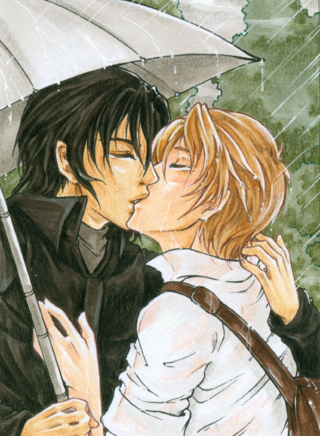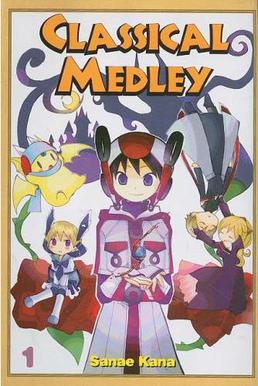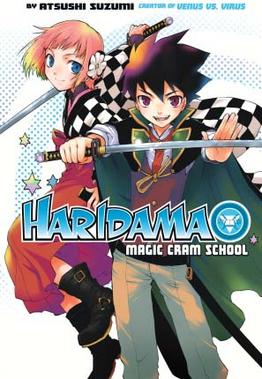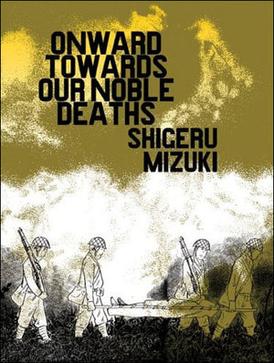
Hentai is a style of Japanese pornographic anime and manga. In addition to anime and manga, hentai works exist in a variety of media, including artwork and video games.

Manga are comics or graphic novels originating from Japan. Most manga conform to a style developed in Japan in the late 19th century, and the form has a long history in earlier Japanese art. The term manga is used in Japan to refer to both comics and cartooning. Outside of Japan, the word is typically used to refer to comics originally published in Japan and published in translation, i.e. a Japanese comic book with English text.

Yaoi, also known as boys' love and its abbreviation BL, is a genre of fictional media originating in Japan that features homoerotic relationships between male characters. It is typically created by women for women and is thus distinct from bara, a genre of homoerotic media marketed to gay men, though yaoi does also attract a male audience and can be produced by male creators. Yaoi spans a wide range of media, including manga, anime, drama CDs, novels, video games, television series, films, and fan works. While "yaoi" is commonly used in the west as an umbrella term for Japanese-influenced media with male-male relationships, "boys' love" and "BL" are the generic terms for this kind of media in Japan and much of Asia.
Ryōsuke Takahashi is a Japanese anime director, screenwriter, and producer. He has worked for Sunrise on many anime shows in the real robot genre, including Armored Trooper VOTOMS, Fang of the Sun Dougram, Panzer World Galient, and Blue Comet SPT Layzner.

Codename: Sailor V is a manga created by Naoko Takeuchi. The series revolves around the character Minako Aino, a cheerful schoolgirl who finds out that she has magical powers that she must use to protect the people of the Earth. Codename: Sailor V is the basis for its sequel, Pretty Soldier Sailor Moon.

Oscar François de Jarjayes is a fictional character created by Japanese manga artist Riyoko Ikeda. She is a major character in the 1972 manga series The Rose of Versailles, and its various adaptations and spin-offs.
Daisuki was a German manga anthology for girls published by Carlsen Verlag. It was the first girl's comics magazine published outside Asia. One edition was about 256 pages long and costs 5.95 Euros in Germany. The chief editor for Daisuki was Anne Berling. Due to declining sales figures, the magazine was discontinued.

Classical Medley is a Japanese manga series written and illustrated by Sanae Kana. It is published in Japan by Softbank.

Haridama Magic Cram School is a one-shot Japanese manga written and illustrated by Atsushi Suzumi. The manga was serialized in Kodansha's shōnen magazine, Monthly Shōnen Sirius, ending the serialization at 5 chapters. The individual chapters were collected by Kodansha into one tankōbon volume which was released on December 22, 2005. The manga is licensed in North America by Del Rey Manga, which published the manga on May 20, 2008. It is also licensed in Taiwan by Sharp Point Press.

Manga: The Complete Guide is a 2007 encyclopedia written by Jason Thompson and published by Del Rey which provides basic details and short reviews of over 1000 Japanese manga titles that have been translated and released in English in North America. Though Thompson is listed as the author on the cover, some titles' entries were initially written by other reviewers, which Thompson later edited.
St. ♥ Dragon Girl is a Japanese manga by Natsumi Matsumoto, who also created Yumeiro Patissiere. It was serialized in Ribon from October 1999 through April 2003. The individual chapters were collected and published in eight volumes by Shueisha. The series focuses on childhood friends Momoka and Ryuga, after Momoka is possessed by a dragon while protecting Ryuga. It is followed by a sequel series titled St. ♥ Dragon Girl Miracle which focuses on Momoko and Ryuga's daughter, Anjuu Sendou.

Peepo Choo is a Japanese manga series written and illustrated by Felipe Smith. It was serialized in Kodansha's manga magazine Monthly Morning Two from June 21, 2008. The individual chapters were collected into three bound volumes by Kodansha, which released them between April 24, 2009, and April 23, 2010. It is licensed in North America by Vertical, which released the three volumes between July 13, 2010, and December 14, 2010.

Onward Towards Our Noble Deaths is a one-shot manga written and illustrated by Shigeru Mizuki. In it, Mizuki describes his experiences as a soldier participating in the New Guinea campaign during World War II. He portrays the final weeks of his infantry service as the soldiers were instructed to die for their country to avoid the dishonor of survival.
In anime and manga, the term "LGBTQ themes" includes lesbian, gay, bisexual and transgender material. Outside Japan, anime generally refers to a specific Japanese-style of animation, but the word anime is used by the Japanese themselves to broadly describe all forms of animated media there. According to Harry Benshoff and Sean Griffin, the fluid state of animation allows flexibility of animated characters to perform multiple roles at once. Manga genres that focus on same-sex intimacy and relationships resulted from fan work that depicted relationships between two same-sex characters. This includes characters who express their gender and sexuality outside of hetero-normative boundaries. There are also multiple sub genres that target specific consumers and themes: yaoi, yuri, shoujo-ai, shonen-ai, bara, etc. LGBT-related manga found its origins from fans who created an "alternative universe" in which they paired their favorite characters together. Many of the earliest works that contained LGBT themes were found in works by dōjinshi who has specifically written content outside the regular industry. The rise of yaoi and yuri was also slowed due to censorship laws in Japan that make it extremely hard for Japanese manga artists ("mangakas") and others to create work that is LGBT themed. Anime that contained LGBTQ content was changed to meet international standards. However, publishing companies continued to expand their repertoire to include yuri and yaoi, and conventions were created to form a community and culture for fans of this work.
THEM Anime Reviews, otherwise known as THEM or T.H.E.M. Anime Reviews, is an anime review website that writes about current and past anime in any form, including OVAs and ONAs. The website offers reviews, editorial content and hosts forums.

Nanohana is a Japanese manga anthology written and illustrated by Moto Hagio. Published from 2011 to 2012 in the manga magazine Monthly Flowers, the series is a collection of one-shots on nuclear power and the Fukushima Daiichi nuclear disaster. Noted as one of the first works on the incident published in Japan, the series focuses on a message of hope in the face of the disaster, while also being a satire that is critical of nuclear power. Nanohana was critically acclaimed upon its release, with Hagio winning a Lifetime Achievement Award at the Sense of Gender Awards for the series in 2012. A theatrical adaptation of the series was staged in 2019.
Sandra Annett is a Canadian film academic. She published the book Anime Fan Communities: Transcultural Flows and Frictions (2014) and is co-editor of the academic journal Mechademia. She is Associate Professor of Film Studies at Wilfrid Laurier University.
Nancy Lunning is an American academic who specializes in anime. She is a Professor Emeritus in Liberal Arts at the Minneapolis College of Art and Design.











